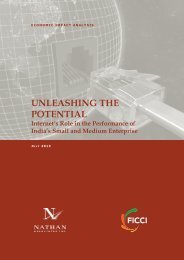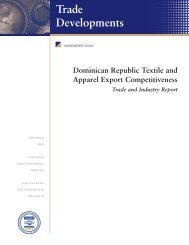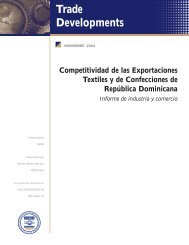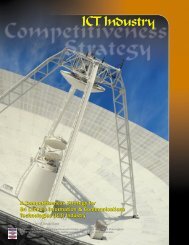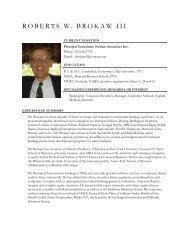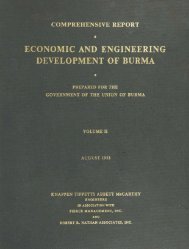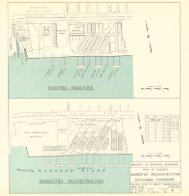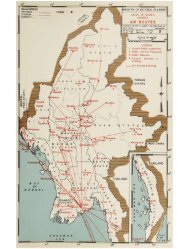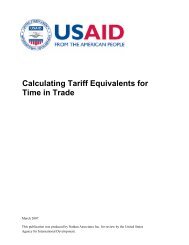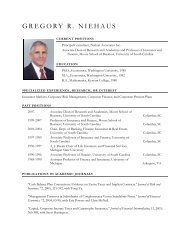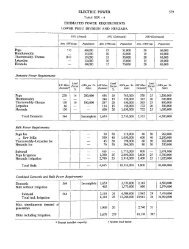Putting it to Work in Developing Countries - Nathan Associates
Putting it to Work in Developing Countries - Nathan Associates
Putting it to Work in Developing Countries - Nathan Associates
You also want an ePaper? Increase the reach of your titles
YUMPU automatically turns print PDFs into web optimized ePapers that Google loves.
<strong>Countries</strong>—The Importance of ICT and<br />
Democratization,” World Inst<strong>it</strong>ute for Development<br />
Economics Research, Discussion Paper No. 2003/45<br />
(May 2003).<br />
13 OECD, “Foreign Direct Investment for<br />
Development, Maximis<strong>in</strong>g Benef<strong>it</strong>s, M<strong>in</strong>imis<strong>in</strong>g<br />
Costs—Overview” (2002), p. 27.<br />
14 The PFI is meant <strong>to</strong> advance the UN’s Monterrey<br />
Consensus on F<strong>in</strong>anc<strong>in</strong>g for Development, which<br />
emphasizes the importance of private <strong>in</strong>vestment <strong>in</strong><br />
development strategies. The OECD M<strong>in</strong>isterial<br />
endorsed the PFI <strong>in</strong> May 2005. The full text of the<br />
OECD Policy Framework for Investment is available at<br />
www.oecd.org/dataoecd/1/31/36671400.pdf.<br />
15 OECD analyzed the pr<strong>in</strong>cipal <strong>in</strong>vestment scoreboards.<br />
It also estimated empirical models <strong>to</strong> expla<strong>in</strong><br />
“<strong>in</strong>ward FDI pos<strong>it</strong>ions <strong>in</strong> develop<strong>in</strong>g countries by<br />
means of basic macroeconomic variables and four of the<br />
<strong>in</strong>vestment scoreboards.” The results seemed <strong>to</strong> “confirm<br />
the conventional macroeconomic wisdom about<br />
the fac<strong>to</strong>rs driv<strong>in</strong>g FDI” (e.g., population and GDP<br />
growth). But they also suggest that large segments of the<br />
scoreboards have l<strong>it</strong>tle predictive power regard<strong>in</strong>g countries’<br />
abil<strong>it</strong>y <strong>to</strong> attract FDI. See OECD, Development<br />
Assistance Comm<strong>it</strong>tee, “Mobilis<strong>in</strong>g Private Assistance<br />
for Development: the Role of ODA— Annex 2: What<br />
guidance can be drawn for <strong>in</strong>vestment climate scoreboards”<br />
DCD/DAC (2004)4/ANN2.<br />
16 MIGA’s Enterprise Benchmark<strong>in</strong>g Program is accessible<br />
at http://www.miga.org/<strong>in</strong>dex.cfmaid=84; and<br />
UNCTAD Investment Policy Reviews: http://www.unctad.org/Templates/Page.asp<strong>in</strong>tItemID=2752&lang=1.<br />
17 The World Bank/IFC has set forth ten lessons for<br />
<strong>in</strong>vestment climate reform, <strong>to</strong>gether w<strong>it</strong>h illustrative<br />
case studies. Some lessons concern reform sequenc<strong>in</strong>g.<br />
All th<strong>in</strong>gs be<strong>in</strong>g equal, one should beg<strong>in</strong> w<strong>it</strong>h trade and<br />
product market reforms by expos<strong>in</strong>g the economy <strong>to</strong><br />
<strong>in</strong>ternational compet<strong>it</strong>ion, or use crisis and pol<strong>it</strong>ical<br />
change <strong>to</strong> undertake bold reform. Others lessons concern<br />
mak<strong>in</strong>g good use of new <strong>in</strong>formation, often gathered<br />
through Do<strong>in</strong>g Bus<strong>in</strong>ess and other benchmark<strong>in</strong>g<br />
approaches, <strong>to</strong> build demand for reform and educate<br />
and empower reform const<strong>it</strong>uencies. Still other lessons<br />
stress the importance of adopt<strong>in</strong>g private sec<strong>to</strong>r change<br />
management techniques <strong>to</strong> create <strong>in</strong>centives and capac<strong>it</strong>y<br />
for implement<strong>in</strong>g <strong>in</strong>vestment climate reforms, as well<br />
as <strong>in</strong>troduc<strong>in</strong>g special oversight mechanisms and mon<strong>it</strong>or<strong>in</strong>g<br />
capabil<strong>it</strong>ies <strong>to</strong> make implementation transparent<br />
and accountable. See Sun<strong>it</strong>a Kikeri, Thomas Kenyon,<br />
and V<strong>in</strong>cent Palmade, Reform<strong>in</strong>g the Investment Climate<br />
Lessons for Pract<strong>it</strong>ioners (Wash<strong>in</strong>g<strong>to</strong>n DC: World Bank,<br />
2006).<br />
18 World Development Report 2005, pp. 12–13.<br />
Performance requirements are “trade-related <strong>in</strong>vestment<br />
measures” (TRIMs), and WTO members were <strong>to</strong> elim<strong>in</strong>ate<br />
such measures under the TRIMs Agreement by<br />
2002. After the Hong Kong M<strong>in</strong>isterial of 2005, <strong>it</strong> was<br />
agreed that least developed countries could extend the<br />
phase-out period until 2020. Analysis by McK<strong>in</strong>sey<br />
Global Inst<strong>it</strong>ute <strong>in</strong> such <strong>in</strong>dustries as au<strong>to</strong>motive and<br />
electronics <strong>in</strong> Brazil, Mexico, Ch<strong>in</strong>a and India suggests<br />
that ne<strong>it</strong>her local content nor jo<strong>in</strong>t venture performance<br />
requirements have been particularly effective <strong>in</strong> stimulat<strong>in</strong>g<br />
spillovers, the typical justification for <strong>in</strong>troduc<strong>in</strong>g<br />
them. Mak<strong>in</strong>g markets compet<strong>it</strong>ive, McK<strong>in</strong>sey f<strong>in</strong>ds, is<br />
more effective. See “The Truth About Foreign Direct<br />
Investment <strong>in</strong> Emerg<strong>in</strong>g Markets,” The McK<strong>in</strong>sey<br />
Quarterly, 2004 Number 1, pp. 32–34.<br />
19 World Development Report 2005, Box 5.5 “One-s<strong>to</strong>p<br />
shops-or one more s<strong>to</strong>p shops” p.101.<br />
20 See Jacques Morisset and Olivier Lumenga Neso,<br />
“Adm<strong>in</strong>istrative Barriers <strong>to</strong> Foreign Investment <strong>in</strong><br />
Develop<strong>in</strong>g <strong>Countries</strong>,” World Bank Policy Research<br />
<strong>Work</strong><strong>in</strong>g Paper (May 2002).<br />
21 All EPZs seek <strong>to</strong> improve the performance of companies<br />
w<strong>it</strong>h<strong>in</strong> them, but w<strong>it</strong>h different <strong>to</strong>ols. Trad<strong>it</strong>ional<br />
EPZs are isolated from the economy, enjoy duty exemptions<br />
and tax <strong>in</strong>centives, and emphasize export earn<strong>in</strong>gs<br />
and low-wage, low-skill jobs. A second type provides<br />
superior <strong>in</strong>frastructure <strong>to</strong> adopt technology which, <strong>in</strong><br />
turn, attracts foreign and domestic <strong>in</strong>vestment that<br />
strengthens an entire <strong>in</strong>dustry or subsec<strong>to</strong>r (e.g.,<br />
Taiwan’s science parks). A third type provides a sett<strong>in</strong>g<br />
for policy experiments (e.g., through <strong>it</strong>s special economic<br />
zones, Ch<strong>in</strong>a has tested and ref<strong>in</strong>ed reform policies<br />
before <strong>in</strong>troduc<strong>in</strong>g them elsewhere).<br />
22 World Development Report 2005, pp. 167.<br />
23 The WTO’s Agreement on Subsidies and<br />
Countervail<strong>in</strong>g Measures ties rules on policies <strong>in</strong> EPZs<br />
<strong>to</strong> country <strong>in</strong>come. LDCs may reta<strong>in</strong> export performance<br />
subsidies as long as they rema<strong>in</strong> under the <strong>in</strong>come<br />
threshold of the SCM Agreement. Nonetheless, a number<br />
of develop<strong>in</strong>g countries are above the thresholds<br />
def<strong>in</strong>ed <strong>in</strong> the agreement, and their EPZ policies may<br />
be <strong>in</strong> violation of <strong>it</strong>.<br />
24 See summary and survey of the benef<strong>it</strong>s of EPZs <strong>in</strong><br />
World Bank, Global Economic Prospects 2003, pp.<br />
83–85. For an overview of EPZs, see Harry G.<br />
Broadman, Africa’s Silk Road, Ch<strong>in</strong>a and India’s New<br />
Economic Frontier (Advance Ed<strong>it</strong>ion), Wash<strong>in</strong>g<strong>to</strong>n, DC:<br />
World Bank (2006), pp. 139–143.<br />
99



